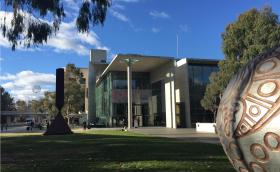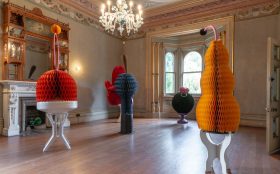We are all racist. Racism exists beneath our verbal and physical communications; it lies within our unconscious prejudices birthed by individual lived experiences that even the best of us cannot avoid.
Willful Subjects, the latest exhibition presented by Nexus Arts, curated by Yusuf Hayat, communicates experiences of living in racially and ethnically diverse societies, and interrogates why racial prejudices persist. It invites the audience to reimagine our relationships and the world.
In the gallery foyer, a tear-off pad hangs on the wall near the exhibition entrance. It reads ‘Unburdening, Unyielding, Imaginings’. On the back of the paper is an essay written by Leah Jing McIntosh, in which she states, ‘In the colony, the racialised body becomes a wrong body, a body to be burdened; expected to yield; blanched of imagination then saturated with colonial memory, amnesiac and cruel.’ To survive in a colony, one must become “willful” subjects, willing to overlook the disturbing histories our world is built upon, willing to accept our place in the system and willing to perpetuate the cognitive dissonance.
The exhibition consists of three videos. The projectors sit around the load-bearing column in the middle of the room. In the space, one can hear chatter from the office and fan noises from the projectors. Admittedly, the exhibition seems to lack installation planning and technical consideration at first glance. During a chat with Hayat, the gallery’s Visual Arts and Community Engagement Lead, he explains that the exhibition has been devised by Nexus Arts staff due to an unexpected gallery vacancy period. It is applaudable that the organisation turned the vacancy into an opportunity for its culturally diverse staff to experiment with their art practices. If given a longer development period, the concept certainly has the potential to become an interactive haptic experience.
The videos display texts slowly sliding across the screen. With the choice of a basic font, the artistic design draws no attention to itself and encourages the audience to focus on the content of the texts. Arial, being a font frequently used in corporate settings, reinforces the idea that racism is deeply embedded in the system.
On the first wall, the video features a set of texts around the idea of Unburdening. This includes racially charged statements. As a person of colour, it is confronting to see words that have caused me harm in the past all displayed on one screen. It is both comforting and upsetting to know someone else has had the same things said to them. Some quotes have been so normalised that we forget they are problematic.
In the second video, the texts are based on the concept of Unyielding. They are statements of uncomfortable truths we live by. They are the conflicting thoughts we hold. They are excuses we make for the system. They are the ugly realities we need to conquer in order for change to happen.
In the third and final video, the texts are about Imaginings. It features different sets of instructions, similar to Yoko Ono’s Grapefruit. The instructions are not grand ideas, but rather simple tasks like ‘Listen to your favourite song. Send it to the person it makes you think of. Tell them you love/miss/support them’ and ‘Get an old newspaper. Write the main headline in ChatGPT. Ask it to rewrite for hope’. A small action can be the drop you need to cause a ripple and start a wave. A change in us is a reflection of a change in the world.
Read: Exhibition review: Still Water, Henri van Noordenburg, Logan Art Gallery
Above all, Willful Subjects is a bold exhibition that interrogates a difficult issue in a manner that encourages reimagination. Despite the technical disadvantage, it is still an impactful and thought-provoking piece.
Willful Subjects is on view from 15 June to 14 July at Nexus Arts, Kaurna/Adelaide; free.
This article is published under the Amplify Collective, an initiative supported by The Walkley Foundation and made possible through funding from the Meta Australian News Fund.






